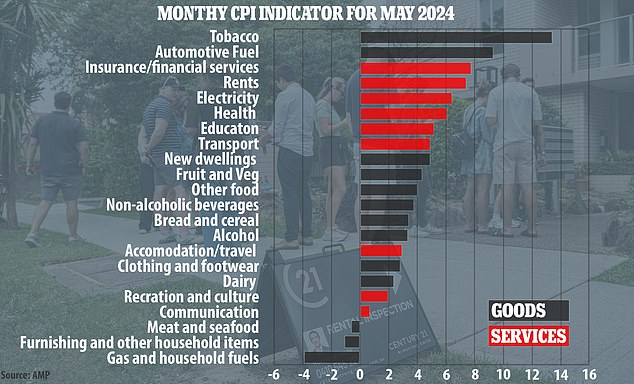A worrying chart compiled by economic experts has revealed that interest rates in Australia could still rise, simply because inflation is now a local problem with immigration at record levels.
The consumer price index rose 4 percent in the year to May, up from 3.6 percent in April, putting inflation further above the Reserve Bank’s 2 to 3 percent target.
That means Australian borrowers face more rate hikes even though Canada and the European Union cut interest rates this month.
Inflation is rising in Australia, but falling in a number of rich world countries, including the UK, US and Sweden.
AMP economists Shane Oliver and My Bui have compiled a new chart highlighting how services, as opposed to goods, made up six of the top 10 items with big price increases.
All of these items were also above the broader inflation rate of 4 percent, showing that Covid supply chain constraints are no longer the key driver of inflation.
“Service prices are more persistent and are the Reserve Bank’s main concern at the moment,” AMP said.
“The upward surprise in monthly inflation data for the past three months is a warning about the bumpy road ahead for the disinflation process, especially as services inflation appears to be picking up.”
A chart has revealed that interest rates in Australia could still rise, highlighting how services, as opposed to goods, made up six of the top 10 items with big price increases and demonstrating that inflation is now a domestic problem with the Immigration at record levels.
Labour’s revised stage three tax cuts, which come into force on July 1, are expected to be spent on essential services, with rent, electricity, healthcare and insurance prices expected to rise at levels much higher than the consumer price index.
“On the one hand, people have a little more money in their pockets,” Ms Bui told Daily Mail Australia.
“They will probably save a lot of these tax cuts; if they are spent, they will probably be used to pay electricity bills, which are still very high right now, pay rent, pay health insurance instead of going out to eat.”
This meant that another rate hike in August, when the RBA meets again, had a 45 per cent chance.
“I think 45 per cent is quite high,” Ms Bui told Daily Mail Australia.
Coalition leader James Paterson said Australian borrowers needed to prepare for possibly two more rate rises.
“Unfortunately, there is a very real risk of one interest rate rise or perhaps two interest rate rises between now and the end of the year or early next year,” he told Sky News on Thursday.

AMP economists Shane Oliver and My Bui (pictured) have compiled a new chart highlighting how services, as opposed to goods, made up six of the top 10 items with big price increases.
Bui said Australia’s high population growth was putting pressure on rents along with demand for goods and services, with a record 547,300 migrants, on a net basis, set to move to Australia in 2023.
This was the largest number recorded in a calendar year based primarily on skilled immigrants and international students, minus permanent departures.
“We’ve also had considerable population growth last year and that has boosted aggregate demand for these essential items a little bit,” he said.
In the price increase graph, tobacco had the largest increase at 13.4 percent, followed by gasoline at 9.3 percent, but both items are also more expensive due to the federal government’s excise tax.
Next six on the list were utilities, with rents increasing by 7.4 percent, electricity costs by 6.5 percent, health costs by 6.1 percent, education by 5.2 percent. percent and transportation 4.9 percent.
“So, yes, some of it was driven from home given the increased demand for everything,” Bui said.
“If you look at the most important services, you see that they are not discretionary: they are things that people actually have to pay for, but they don’t really have a choice about it.”
This month, the Reserve Bank left interest rates unchanged at a 12-year high of 4.35 per cent.
But more bad news in the more comprehensive June quarter inflation data on July 31 could see the RBA raise rates after it meets again on August 5-6.


